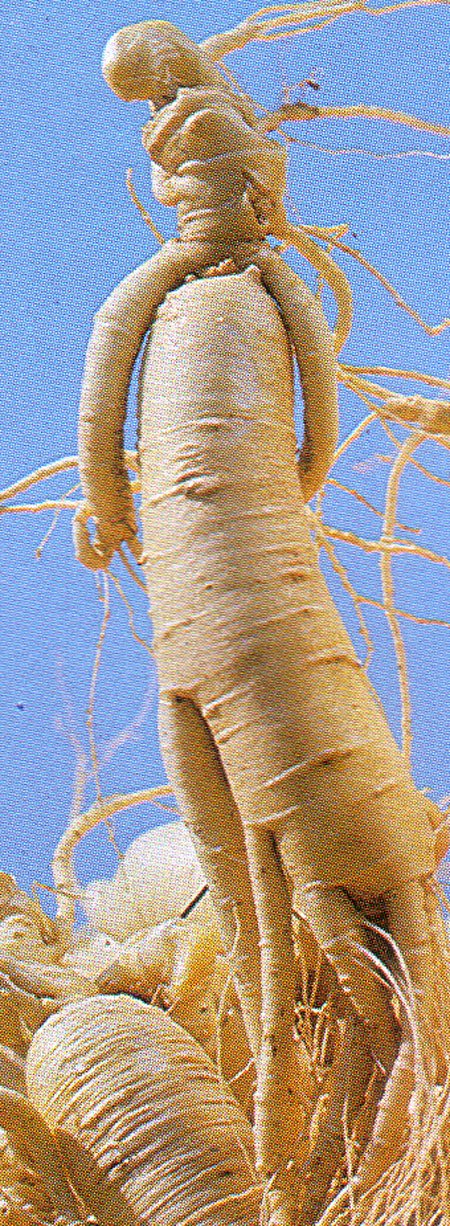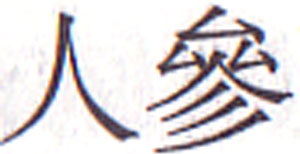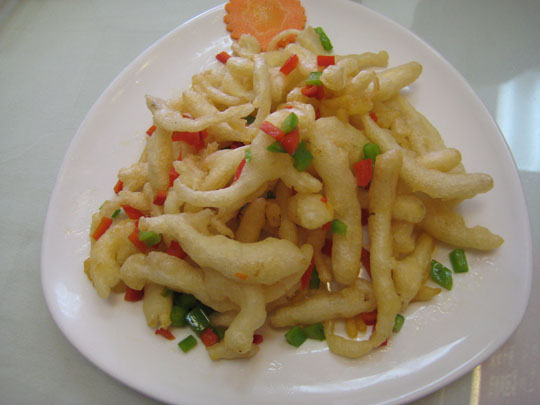
| What is Flavor and Fortune? |
| How do I subscribe? |
| How do I get past issues? |
| How do I advertise? |
| How do I contact the editor? |
Read 13089268 times
Connect me to:
| Home |
| Articles |
| Book reviews |
| Letters to the Editor |
| Newmans News and Notes |
| Recipes |
| Restaurant reviews |
| Article Index (all years, slow) |
| List of Article Years |
| Article Index (2025) |
| Article Index (last 2 years) |
| Things others say |
| Related Links |
| Log In... |
| Authors |
| Categories & Topics |
Ginseng: An Ancient Botanical
| by Jacqueline M. Newman |
Food as Herbs, Health, and Medicine
Fall Volume: 2010 Issue: 17(3) page(s): 26, 28, and 30
Ancient, yes! A several-year-old root, yes! Of intense popular interest, yes! Good for many, many things, including longevity, yes! Taken by everyone who wants to be healthy and live long, no!

 This Northeast treasure, one of three; the others are the marten and the pilose antler. All have been considered precious for thousands of years, this one is often called the king of a hundred herbs. Ginseng is expensive, a perennial, and an item discovered, cultivated, and processed in China long before it was anywhere else. It is a root, often human-shaped, and it looks like a white carrot with a tan exterior and lots of extra skinny root regions. Said to be good for health, why is everyone not consuming it?
This Northeast treasure, one of three; the others are the marten and the pilose antler. All have been considered precious for thousands of years, this one is often called the king of a hundred herbs. Ginseng is expensive, a perennial, and an item discovered, cultivated, and processed in China long before it was anywhere else. It is a root, often human-shaped, and it looks like a white carrot with a tan exterior and lots of extra skinny root regions. Said to be good for health, why is everyone not consuming it?
Known at least since the Han Dynasty (206 BCE - 220 CE) when it was recorded in the Shen Nong Materia Medica, there are many who spend big bucks to buy it, then decoct it, even eat it in different dishes. It is considered a panacea or magical potion; and its botanical name of 'panax' does mean 'all-healing.'
Some wonder where ginseng is grown and harvested, and how. That is an easy question to answer if one asks on which continent; there are three main ones. As to how, this is a root, need one say more?
In China, almost everyone knows this is a northeastern Chinese food that grows at the foot of or in lower regions of many a mountain. They know it as a dietary supplement used since ancient times; and some know and cook it in a few of their dishes. They may also know it is found in China, Korea, Japan, Russia, and in the United States, and that now it is cultivated, even propagated from seeds.
One of the most popular places in China to find ginseng is in Fusong County in the Northeast Province of Jilin, near the Changbai mountain range. Going to find ginseng used to be big business, successful business, and a profitable business that needed lots of hand labor. To get ginseng used to mean finding then carefully digging it out. Then one needed to clean and dry it, and finally to sell it. Nowadays, it is cultivated in beds, machine dug then machine shaken to loosen the soft sandy soil around the roots, then washed and hand trimmed.
Recent written materials on this herbal can be found in early imperial records, and more recently, in Tang and Song Dynasty recorded information (618 - 907 and 960 - 1280 CE, respectively). During these latter dynastic times, this botanical was a tribute food sent to their emperors.
People used to, and some still do try to find, dig, and gather this root. They go to the places where it does grow wild usually in late summer when the berries growing on top; these turn bright or dark red and point to where it lies below. However, few actually do this any more because they know that finding wild ginseng is rare. More and more places cultivate this slow-growing root that likes shade, some sunlight, high humidity, and a cool climate. They know its roots are small, every tiny branch worth carefully collecting and saving, and should they really be lucky, one a quarter to half pound would be a lifetime of treasure.
Some roots have been harvested weighting about a pound, but that is exceptionally rare. Most roots might be tinged with pink or red, and lots are less than half pound in weight. The best, that is the most efficacious, are said to be sun-dried. Others are washed and oven baked. These are ones more readily available and not as expensive.
Many wonder what gives the ginseng root its traditional Chinese medicinal or health qualities, and exactly what these qualities are. Some answers can be found in previous issues of Flavor and Fortune; check them out at www.flavorandfortune.com Check out Volume 3(1) on page 15, Volume 4(3) on page 10, and Volume 10(4) on page 6. A more complete discussion follows and includes recipes for those who want to use this herbal in their culinary.
Ginseng has many different volatile oils, amino acids, vitamins and an important component known as ginseng saponin. This root with its glycoside, also known as a ginsenoside, is the conservator of health the Chinese use as an herbal decoction or tea, or in any manner of cooking. The main purpose that folks consume this plant is that they say it improves the nervous system enhancing nerve growth, improves the functioning of the heart, and that it can inhibit cancer.
The Chinese say its valuable components are also found in lesser amounts in the leaves of the plant, in its fruit (sometimes called its berries) and of course in the parts that growm below ground. All parts of the ginseng plant are used in many types of pills, powders, and potions; all are costly but in different amounts, and all are considered desirable.
Ginseng is used by the elderly and those going to be elderly to increase their appetite, strengthen their immune system, fight their fatigue, reduce their blood pressure, and aid their decreasing mental capacities. Men use it to enhance their sexual desire and activities as it is said to raise their testosterone levels. Women use it for items mentioned above, for its nourishment, and more.
 These days, ginseng is popular as a tea. It can be found in sodas, chewing gum, fruit drinks, candies, and in alcoholic beverages. In restaurants and in some homes, it is prepared with chicken, and with duck, fish, and meat. Hard to locate in restaurant dishes, there is one place we have had it simply batter-fried and fantastic (see the picture on this page), and that was at M & T RESTAURANT at 44-09 Kissena Boulevard in Flushing NY 11355. For those that use beauty parlors, ginseng is also available for external use in facial creams and hair rinses.
These days, ginseng is popular as a tea. It can be found in sodas, chewing gum, fruit drinks, candies, and in alcoholic beverages. In restaurants and in some homes, it is prepared with chicken, and with duck, fish, and meat. Hard to locate in restaurant dishes, there is one place we have had it simply batter-fried and fantastic (see the picture on this page), and that was at M & T RESTAURANT at 44-09 Kissena Boulevard in Flushing NY 11355. For those that use beauty parlors, ginseng is also available for external use in facial creams and hair rinses.
Ginseng is expensive because it is a slow-growing plant that produces three to five little leaves its first year, a few more each year thereafter, and it forks or branches each year after that. A ginseng root sends up seven or eight half-moon-shaped red seeds off its almost-man-shaped root; and that shape may be why many say it is good for human energy or qi, and for human health.
In the above-mentioned Shen Nong volume, it is recorded that ginseng is good for the five internal organs, namely heart, liver, spleen, lungs, and kidneys. They also say it is good for the eyes, an item to lift one’s spirits, improve the functioning of the brain, and lengthening life. That was then, current Chinese medical research reports it can reduce blood sugar, increase qi, help make red blood cells, increase resistence to disease, and keep skin young and supple.
In the western world, the use of ginseng means using one of three main plants. There is Asian ginseng which comes from China and/or Korea and botanically called Panax ginseng. This variety is said to act upon lung and spleen channels and reduce cold and deficient syndromes. American ginseng which comes from Canada, France, or the United States is botanically called Panax quinquefolius and it is said to act on lung, heart, and kidney channels. Siberian ginseng which comes from Northern Russia, is botanically known as Eleutherococcus senticosus and used similarly to Asian ginseng. All ginseng varieties are used in dried root forms, all are in the Araliaceae family. The Chinese consider the Asian variety the most potent.
Speaking of potency, roots five years or older, the Chinese says are 'the essence of the earth in the form of man.' They are considered the best to use. Furthermore, they believe that white ginseng is carefully dried in the sun, reddish ones often steam-processed causing that hue. Also, Traditional Chinese Medicinal practitioners (TCM doctors) tout that Asian ginseng is yang, male and warming while American ginseng is yin, cooling, and female. Many of them consider Siberian ginseng very close to Asian ginseng, and that it is also male.
Integrative Medicine, an herbal group, reports that Asian ginseng slows aging, strengthens the immune system, regulates blood sugar, boosts high-density lipoprotein, is an anti-tumor agent, regenerates liver cells, is a tonic that quiets the spirit and decreases agitation, treats shortness of breath, enhances both abstract thinking and athletic performance, and it treats impotence.
They say that American ginseng counters the harmful effects of stress, calms the body, treats lung weakness, treats fever accompanied by thirst, and reduces stomach heat. When speaking about Siberian ginseng, they write that it lowers back pain, treats kidney problems, normalizes body functions, enhances physical and therefore athletic performance, lowers blood cholesterol, normalizes blood glucose levels, is an anti-tumor agent, reduces effects of chemical carcinogens, ameliorates effects of chemotherapy drugs, and protects against radiation-induced damage. Therefore, one can see that people believe ginseng normalizes a wide range of body functions and enhances ability to carry out its functions.
Locating recipes to use this herbal is no easy task. Should you want to deep-fry some thin pieces of it, the one pictured was made using a wheat flour and egg white batter. There is that one and two other recipes to help prepare and consume this much-touted herbal.
| Ginseng Chicken Broth |
|---|
1 four to five pound chicken, insides removed and rinsed 1 Tablespoon coarse salt, divided in half 1 medium to large ginseng root, rinsed well but not peeled 1/2 cup goji berries 1/2 cup Job’s tears 2 large onions, cut in quarters 1 large knob fresh ginger, cut in half, then each piece smashed with the side of a cleaver 3 Tablespoons soy sauce 1 teaspoon sesame oil 1 scallion, minced 1 clove garlic, minced 2 slices fresh ginger, peeled and minced 1/2 teaspoon Chinese black vinegar Preparation: 1. Rub the half portion of salt on the inside and outside of the chicken, and allow to rest for half an hour. 2. In a large soup pot, bring six quarts of water to the boil then carefully add the chicken so as not to get scalded. Reduce the heat and scum, as needed for five minutes then add ginseng root, goji berries, Job’s tears, onions, and the ginger. Simmer for three hours, turning the chicken three or four times. Then remove the chicken to a serving bowl. 3. While the chicken is cooking, mix soy sauce, sesame oil, scallion, garlic, and ginger pieces, and the vinegar, and put into a small bowl to be used for dipping. 4. Spread the other ingredients around the chicken, and eat it tearing off pieces with chopsticks. Dip the pieces of chicken into the sauce, if desired, eat the herbal items plain. |
| Ginseng, Pork, and Pine Nut Soup |
|---|
1 pound shin pork, cut into two-inch pieces 2 small ginseng roots, about half cup, each cut into one-inch pieces 3 Tablespoons Job's tears 3 Tablespoons pine nuts 1 piece tangerine peel, soaked until soft 3 candied Chinese brown or black dates, each cut into four pieces 2 zucchini, peeled, each cut into eight pieces salt and pepper, to taste Preparation: 1. Put the pork into a large soup pot with eight quarts of water, bring to the boil, remove scum, then reduce the heat to simmer. 2. Add the ginseng, jobs tears, pine nuts, tangerine peel, and the cut-up dates and simmer for two hours. 3. Add another two quarts of water and the zucchini and simmer for another forty minutes then season with salt and pepper and simmer another ten minutes. Then serve. |
| Restoration Tea |
|---|
1 one-inch square piece of ginseng, diced, then smashed with the side of a cleaver 12 black Chinese dates, rinsed 2 Tablespoons granulated sugar Preparation: 1. Put ginseng, Chinese dates, and sugar in a glass or a pot with a non-reactive surface. Add one quart of water and bring to the boil. As soon as it starts to boil, reduce the heat and simmer on low for two hours. 2. Serve hot or tepid. |

Copyright © 1994-2025 by ISACC, all rights reserved
Address
3 Jefferson Ferry Drive
S. Setauket NY 11720